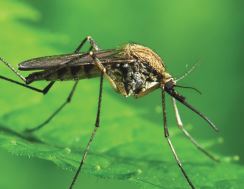
Call today for your free wraps around your Bite-Lite® Natural Mosquito Repellent Candles!
A great way to highlight your doorstep or path to the haunted house!

Call today for your free wraps around your Bite-Lite® Natural Mosquito Repellent Candles!
A great way to highlight your doorstep or path to the haunted house!
Today’s report on CNN Health by Senior Medical Correspondent Elizabeth Cohen states that this season’s West Nile virus outbreak is the largest to date in the United States, with 1,118 reported cases, including 42 deaths. Most cases have occurred in Mississippi, Louisiana, South Dakota, Oklahoma, and primarily in Texas, where 586 cases and 21 deaths have been confirmed.
Please read the entire article on CNN Health
Here is a summary 5 things you need to know about West Nile virus as outlined in the article:
We can’t stress enough how important it is to protect yourself from mosquitoes. Bite-Lite® Natural Mosquito Repellent Candles are scientifically proven natural repellents that will help keep mosquitoes from finding and biting you.
FAQ’s on burning candles: Bite-Lite® Natural Mosquito Repellent Candles are meant to be burned outdoors. But you will find that outdoor temperatures have a profound effect on the way any candles burn outside, as well as how the melted wax pool forms. As a result, we at Bite-Lite® would like to offer the following tips:
Safety Tips:
What can I expect when using Bite-Lite® Natural Repellent Candles?
No mosquito control candle will give 100% protection; however, when using an appropriate number of candles (minimum 2-3) for the area, you should achieve a significant reduction in the number of mosquito landings approaching 75-80%.
How do I use Bite‑Lite® Natural Repellent Candles?
For best results, it is important to light the candles 20 minutes before going outside. It is best to light at least 2-3 candles to protect the area that you’ll be occupying; more for larger groups of people. Also, all repellent candles are most effective when there is little or no wind to quickly disperse the repellent. If there is wind, be sure the vapors from the candles are between you and the mosquitoes. The Spearmint and Lemongrass Oils are released from the candles by evaporation from the hot, melted pool of wax that forms while the candle is burning. (Note: The oils in Bite-Lite natural repellents are not released from the flame.)
Most mosquitoes rest during the day and come out at dusk. If the repellent candles are burned before you go outdoors or before the mosquitoes become active, they may move away from the space you are trying to protect and not find their way back easily when you go outside. Mosquitoes find you most easily if they’re already close and can sense your heat signature.
These are just some of the tips from our FAQ page that you should be aware of when using our candles to prolong the effectiveness of your candles, along with basic safety reminders. Read more information about Bite-Lite natural repellents on FAQ’s.

Each year the week of June 26 is declared National Mosquito Control Awareness Week by the American Mosquito Control Association (AMCA). AMCA’s “Mosquito Week” educates the general public about the significance of mosquitoes in their daily lives and the important service provided by mosquito control workers throughout the United States and worldwide.
The AMCA, an international organization of nearly 2,000 public health professionals, has been dedicated to preserving the public’s health and well-being through safe, environmentally sound mosquito control programs since 1935.
During “Mosquito Week” the AMCA’s goal is to educate the general public about the significance of mosquitoes in their daily lives and the important service provided by mosquito control workers throughout the United States and worldwide.
Bite-Lite® Mosquito Repelling Candles offer an effective and safe method of preventing mosquitoes from biting with its proprietary Cloak & Scatter® Technology. Read more on The Science page.
|
Kevin Sorbo takes a bite out of Bite-Lite Candle! |
If you’ve been following our At The Grammys and At The Oscars pages on our website, you already know that Hollywood celebrities really love Bite-Lite® NATURAL Mosquito Repellent Candles! After successful appearances at these two events, Bite-Lite® has been invited back to Hollywood to appear at a special Rodeo Drive event for the 2012 MTV Movie Awards on May 31st. The Stars will be there to help bring awareness to the charity Children of the Night.
We’ll let you know which stars are there and who stops by to get their special gift from Bite-Lite – check our Facebook page or follow @bitelite for updates. The 2012 MTV Movie Awards Show is Sunday June 3rd at 9 pm EST on MTV. You can still vote for your favorite movie and stars on the show’s website – watch and see who wins this popular film industry event!
Mosquito born diseases have been around for awhile in other parts of the world, but we are seeing more cases in the United States. See this video from NBC Connecticut for more about the Rock Pool Mosquito. This aggressive “day-biter” is known to carry West Nile Virus, Dengue Fever, and Encephalitis. How to protect your family and yourself? Number one on the list is removing standing water from your yard and house – empty flower pots, basins, and any other areas where water can accumulate after a rain or when you irrigate your lawn. To help repel mosquitoes, use Bite-Lite® Natural Mosquito Repellent Candles when you have outdoor events. Their patent pending formula of natural essential oils has been proven effective in “Cloaking” you from mosquitoes – if mosquitoes can’t find you, they can’t bite you! See The Science page for more information and our FAQ’s on how to use most effectively use our natural repellent candles.
If you have trouble viewing the video here, here is the direct link to the NBC Connecticut website: http://www.nbcconnecticut.com/video/#!/news/health/Mosquito-Threat/124433479%0A
View more videos at: http://nbcconnecticut.com
Do you have questions about mosquitoes? A great resource is the FAQ’s section you can find on the American Mosquito Control Association website.
You might want to know –
What good do mosquitoes do?
Mosquitoes fill a variety of niches which nature provides. As such, placing a value on their existence is generally inappropriate. Although the fossil record is incomplete, they have been known since the Cretaceous Period (about 100 million years ago) in North America. Their adaptability has made them extraordinarily successful, with upwards of 2,700 species worldwide. Mosquitoes serve as food sources for a variety of organisms but are not crucial to any predator species.
or–
Can mosquitoes transmit AIDS?
Many studies have been conducted on this issue in the United States and abroad. To our kowledge, there has never been a successful transfer of the virus from an infected source to another host by bloodfeeding insects under experimental conditions. The experts have concluded that these insects are not capable of such transmission. Many biological reasons would lead one to this same conclusion, but the extensive experimental studies are the most powerful evidence for the conclusion.
These are just a few of the science-based facts you will see on this resourceful website.
 Mosquitoes are insects belonging to the order Diptera, the True Flies. Like all True Flies, mosquitoes have two wings, but unlike other flies, mosquitoes have wings with scales. The mouthparts of female mosquitoes form a long piercing-sucking proboscis. Males differ from females by having feathery antennae and mouthparts not suitable for piercing skin. A mosquito’s principal food is nectar or similar sugar source.
There are over 3,000 different species of mosquitoes throughout the world; currently 176 species are recognized in the United States. A new species, Anopheles grabhamii, was reported from the Florida Keys in 2001 (Darsie et al. 2002). Each mosquito species has a Latin scientific name, such as Anopheles quadrimaculatus. Anopheles is the “generic” name of a group of closely related mosquitoes; quadrimaculatus is the “species” name that represents a group of individuals that are similar in structure and physiology and capable of interbreeding. These names are used in a descriptive manner so that the name tells something about each particular mosquito. For example, Anopheles means hurtful or prejudicial in Greek; quadrimaculatus means four spots (4 dark spots on the wings) in Latin. Some species have what are called “common names” as well as scientific names, such as Ochlerotatus taeniorhynchus, the “black salt marsh mosquito.”
Scientific investigators (taxonomists) are constantly looking for new mosquitoes, as well as reviewing previously identified specimens for new information or identifying characteristics. Better microscopic equipment developed in the last 20 years has improved the taxonomist’s ability to determine differences between species. Recently such a review by Dr. John Reinert (2000) led to a change in the name of many mosquitoes belonging to the genus Aedes. Using improved methods and over 30 years’ experience, he elevated a subgenus of Aedes ( Ochlerotatus ) to the status of genus. This will necessitate the renaming of many mosquitoes previously named Aedes to the genus Ochlerotatus and the rewriting of many taxonomic keys important to public health entomologists working in mosquito control.
”
The Spanish called mosquitoes “musketas,” and the native Hispanic Americans called them “zancudos.” “Mosquito” is a Spanish or Portuguese word meaning “little fly” while “zancudos,” a Spanish word, means “long-legged.” The use of the word “mosquito” is apparently of North American origin and dates back to about 1583. In Europe, mosquitoes were called “gnats” by the English, “Les moucherons” or “Les cousins” by French writers, while the Germans used the name “Stechmucken” or “Schnacke.” In Scandinavian countries mosquitoes were called by a variety of names including “myg” and “myyga.” and the Greeks called them “konopus.” In 300 B.C., Aristotle referred to mosquitoes as “empis” in his “Historia Animalium” where he documented their life cycle and metamorphic abilities. Modern writers used the name Culex, and it is retained today as the name of a mosquito genus. What is the correct plural form of the word mosquito? In Spanish it would be “mosquitos,” but in English “mosquitoes” (with the “e”) is correct.
Mosquitoes can be an annoying, serious problem in man’s domain. They interfere with work and spoil hours of leisure time. Their attacks on farm animals can cause loss of weight and decreased milk production. Some mosquitoes are capable of transmitting diseases such as malaria, yellow fever, dengue, filariasis, and encephalitis [St. Louis encephalitis (SLE)], Western Equine encephalitis (WEE), LaCrosse encephalitis (LAC), Japanese encephalitis (JE), Eastern Equine encephalitis (EEE), and West Nile virus (WNV)] to humans and animals.
Mosquitoes are insects belonging to the order Diptera, the True Flies. Like all True Flies, mosquitoes have two wings, but unlike other flies, mosquitoes have wings with scales. The mouthparts of female mosquitoes form a long piercing-sucking proboscis. Males differ from females by having feathery antennae and mouthparts not suitable for piercing skin. A mosquito’s principal food is nectar or similar sugar source.
There are over 3,000 different species of mosquitoes throughout the world; currently 176 species are recognized in the United States. A new species, Anopheles grabhamii, was reported from the Florida Keys in 2001 (Darsie et al. 2002). Each mosquito species has a Latin scientific name, such as Anopheles quadrimaculatus. Anopheles is the “generic” name of a group of closely related mosquitoes; quadrimaculatus is the “species” name that represents a group of individuals that are similar in structure and physiology and capable of interbreeding. These names are used in a descriptive manner so that the name tells something about each particular mosquito. For example, Anopheles means hurtful or prejudicial in Greek; quadrimaculatus means four spots (4 dark spots on the wings) in Latin. Some species have what are called “common names” as well as scientific names, such as Ochlerotatus taeniorhynchus, the “black salt marsh mosquito.”
Scientific investigators (taxonomists) are constantly looking for new mosquitoes, as well as reviewing previously identified specimens for new information or identifying characteristics. Better microscopic equipment developed in the last 20 years has improved the taxonomist’s ability to determine differences between species. Recently such a review by Dr. John Reinert (2000) led to a change in the name of many mosquitoes belonging to the genus Aedes. Using improved methods and over 30 years’ experience, he elevated a subgenus of Aedes ( Ochlerotatus ) to the status of genus. This will necessitate the renaming of many mosquitoes previously named Aedes to the genus Ochlerotatus and the rewriting of many taxonomic keys important to public health entomologists working in mosquito control.
”
The Spanish called mosquitoes “musketas,” and the native Hispanic Americans called them “zancudos.” “Mosquito” is a Spanish or Portuguese word meaning “little fly” while “zancudos,” a Spanish word, means “long-legged.” The use of the word “mosquito” is apparently of North American origin and dates back to about 1583. In Europe, mosquitoes were called “gnats” by the English, “Les moucherons” or “Les cousins” by French writers, while the Germans used the name “Stechmucken” or “Schnacke.” In Scandinavian countries mosquitoes were called by a variety of names including “myg” and “myyga.” and the Greeks called them “konopus.” In 300 B.C., Aristotle referred to mosquitoes as “empis” in his “Historia Animalium” where he documented their life cycle and metamorphic abilities. Modern writers used the name Culex, and it is retained today as the name of a mosquito genus. What is the correct plural form of the word mosquito? In Spanish it would be “mosquitos,” but in English “mosquitoes” (with the “e”) is correct.
Mosquitoes can be an annoying, serious problem in man’s domain. They interfere with work and spoil hours of leisure time. Their attacks on farm animals can cause loss of weight and decreased milk production. Some mosquitoes are capable of transmitting diseases such as malaria, yellow fever, dengue, filariasis, and encephalitis [St. Louis encephalitis (SLE)], Western Equine encephalitis (WEE), LaCrosse encephalitis (LAC), Japanese encephalitis (JE), Eastern Equine encephalitis (EEE), and West Nile virus (WNV)] to humans and animals.
Bite-Lite® Natural Mosquito Repellent Candles celebrate Spring with FREE SHIPPING
on all retail sales through the end of the month! No need to use a special code. Free shipping will be automatically applied when you check out. Visit our Products page and take advantage — stock up before mosquito season gets fully underway.

Enter your details below to save your shopping cart for later. And, who knows, maybe we will even send you a sweet discount code :)